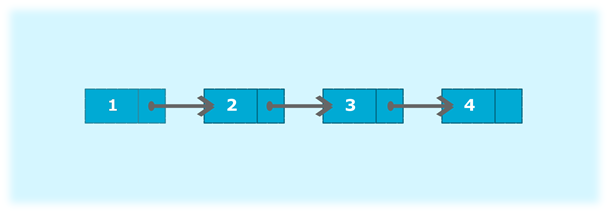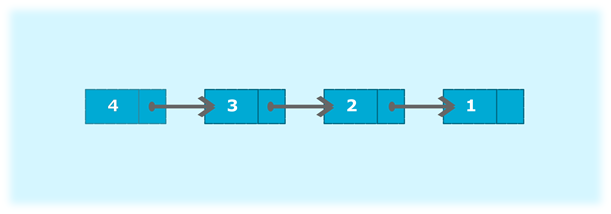📌 相关文章
- 数据结构示例-创建n个节点的循环链表并反序打印(1)
- 数据结构示例-n个节点的双向链表列表并反序打印
- 数据结构示例-n个节点的双向链表列表并反序打印(1)
- 数据结构-单链表
- 数据结构-单链表(1)
- 数据结构-循环单链表(1)
- 数据结构-循环单链表
- 数据结构示例-创建N个节点单链表与计数
- 数据结构示例-创建单链表并打印
- 数据结构示例-从头部删除单链表节点(1)
- 数据结构示例-从头部删除单链表节点
- 单链表所有素节点的和与积(1)
- 单链表所有素节点的和与积
- c# 单链表 - C# (1)
- 单链表 (1)
- c# 单链表 - C# 代码示例
- 从单链列表中选择一个随机节点
- 从单链列表中选择一个随机节点(1)
- 单链表 - 任何代码示例
- java代码示例中的单链表
- java中的单链表(1)
- 单链表创建包含 3 个节点插入一个节点,数据为 50 - Javascript 代码示例
- 可被 K 整除的循环单链表节点的和和积(1)
- 可被 K 整除的循环单链表节点的和和积
- 单链表创建包含 3 个节点插入一个节点,数据为 50 - Javascript (1)
- 数据结构示例-创建n个节点的循环链表并计算节点数(1)
- 数据结构示例-创建n个节点的循环链表并计算节点数
- 单链表中可被 K 整除的节点的和与积(1)
- 单链表中可被 K 整除的节点的和与积
📜 数据结构示例-创建n个节点的单链表列表并反序打印
📅 最后修改于: 2020-10-15 04:47:29 🧑 作者: Mango
程序创建n个节点的单链接列表并以相反顺序显示
说明
在此程序中,我们需要创建一个单链列表并以相反的顺序显示该列表。
原始清单

冲销清单

解决此问题的方法之一是到达列表的末尾,并从尾到头递归显示节点。
算法
- 创建一个具有两个属性的类Node:data和next。下一个是指向列表中下一个节点的指针。
- 创建另一个具有两个属性的类:head和tail。
- addNode()将向列表添加一个新节点:
- 创建一个新节点。
- 它首先检查head是否等于null,这意味着列表为空。
- 如果列表为空,头和尾都将指向新添加的节点。
- 如果列表不为空,则新节点将被添加到列表的末尾,使得尾部的下一个将指向新添加的节点。这个新节点将成为列表的新尾部。
- reverse()将颠倒列表中存在的节点的顺序。
- 此方法检查current旁边的节点是否为null,这表示current指向尾部,然后将print出tail节点的数据。
- 通过考虑当前节点旁边的节点来递归调用reverse(),并从尾部开始以相反顺序打印出所有节点。
- display()将显示列表中存在的节点:
- 定义一个节点电流,该电流将初始指向列表的开头。
- 遍历列表,直到当前指向null。
- 通过在每次迭代中使电流指向其旁边的节点来显示每个节点。
示例:
Python
#Represent a node of the singly linked list
class Node:
def __init__(self,data):
self.data = data;
self.next = None;
class ReverseList:
#Represent the head and tail of the singly linked list
def __init__(self):
self.head = None;
self.tail = None;
#addNode() will add a new node to the list
def addNode(self, data):
#Create a new node
newNode = Node(data);
#Checks if the list is empty
if(self.head == None):
#If list is empty, both head and tail will point to new node
self.head = newNode;
self.tail = newNode;
else:
#newNode will be added after tail such that tail's next will point to newNode
self.tail.next = newNode;
#newNode will become new tail of the list
self.tail = newNode;
#reverse() will the reverse the order of the list
def reverse(self, current):
#Checks if list is empty
if(self.head == None):
print("List is empty");
return;
else:
#Checks if the next node is None, if yes then prints it.
if(current.next == None):
print(current.data ,end=" ");
return;
#Recursively calls the reverse function
self.reverse(current.next);
print(current.data ,end=" ");
#display() will display all the nodes present in the list
def display(self):
#Node current will point to head
current = self.head;
if(self.head == None):
print("List is empty");
return;
while(current != None):
#Prints each node by incrementing pointer
print(current.data , end=" ");
current = current.next;
print();
sList = ReverseList();
#Add nodes to the list
sList.addNode(1);
sList.addNode(2);
sList.addNode(3);
sList.addNode(4);
print("Original List: ");
sList.display();
print("Reversed List: ");
#Print reversed list
sList.reverse(sList.head);
输出:
Original List:
1 2 3 4
Reversed List:
4 3 2 1
C
#include
//Represent a node of the singly linked list
struct node{
int data;
struct node *next;
};
//Represent the head and tail of the singly linked list
struct node *head, *tail = NULL;
//addNode() will add a new node to the list
void addNode(int data) {
//Create a new node
struct node *newNode = (struct node*)malloc(sizeof(struct node));
newNode->data = data;
newNode->next = NULL;
//Checks if the list is empty
if(head == NULL) {
//If list is empty, both head and tail will point to new node
head = newNode;
tail = newNode;
}
else {
//newNode will be added after tail such that tail's next will point to newNode
tail->next = newNode;
//newNode will become new tail of the list
tail = newNode;
}
}
//reverse() will the reverse the order of the list
void reverse(struct node *current) {
//Checks if list is empty
if(head == NULL) {
printf("List is empty\n");
return;
}
else{
//Checks if the next node is null, if yes then prints it.
if(current->next == NULL) {
printf("%d ", current->data);
return;
}
//Recursively calls the reverse function
reverse(current->next);
printf("%d ", current->data);
}
}
//display() will display all the nodes present in the list
void display() {
//Node current will point to head
struct node *current = head;
if(head == NULL) {
printf("List is empty\n");
return;
}
while(current != NULL) {
//Prints each node by incrementing pointer
printf("%d ", current->data);
current = current->next;
}
printf("\n");
}
int main()
{
//Add nodes to the list
addNode(1);
addNode(2);
addNode(3);
addNode(4);
printf("Original List: \n");
display();
printf("Reversed List: \n");
//Print reversed list
reverse(head);
return 0;
}
输出:
Original List:
1 2 3 4
Reversed List:
4 3 2 1
JAVA
public class ReverseList {
//Represent a node of the singly linked list
class Node{
int data;
Node next;
public Node(int data) {
this.data = data;
this.next = null;
}
}
//Represent the head and tail of the singly linked list
public Node head = null;
public Node tail = null;
//addNode() will add a new node to the list
public void addNode(int data) {
//Create a new node
Node newNode = new Node(data);
//Checks if the list is empty
if(head == null) {
//If list is empty, both head and tail will point to new node
head = newNode;
tail = newNode;
}
else {
//newNode will be added after tail such that tail's next will point to newNode
tail.next = newNode;
//newNode will become new tail of the list
tail = newNode;
}
}
//reverse() will help the reverse the order of the list
public void reverse(Node current) {
//Checks if list is empty
if(head == null) {
System.out.println("List is empty");
return;
}
else {
//Checks if the next node is null, if yes then prints it.
if(current.next == null) {
System.out.print(current.data + " ");
return;
}
//Recursively calls the reverse function
reverse(current.next);
System.out.print(current.data + " ");
}
}
//display() will display all the nodes present in the list
public void display() {
//Node current will point to head
Node current = head;
if(head == null) {
System.out.println("List is empty");
return;
}
while(current != null) {
//Prints each node by incrementing pointer
System.out.print(current.data + " ");
current = current.next;
}
System.out.println();
}
public static void main(String[] args) {
ReverseList sList = new ReverseList();
//Add nodes to the list
sList.addNode(1);
sList.addNode(2);
sList.addNode(3);
sList.addNode(4);
System.out.println("Original List: ");
sList.display();
System.out.println("Reversed List: ");
//Print reversed list
sList.reverse(sList.head);
}
}
输出:
Original List:
1 2 3 4
Reversed List:
4 3 2 1
C#
using System;
public class ReverseList
{
//Represent a node of the singly linked list
public class Node{
public T data;
public Node next;
public Node(T value) {
data = value;
next = null;
}
}
public class SinglyLinkedList{
//Represent the head and tail of the singly linked list
public Node head = null;
public Node tail = null;
//addNode() will add a new node to the list
public void addNode(T data) {
//Create a new node
Node newNode = new Node(data);
//Checks if the list is empty
if(head == null) {
//If list is empty, both head and tail will point to new node
head = newNode;
tail = newNode;
}
else {
//newNode will be added after tail such that tail's next will point to newNode
tail.next = newNode;
//newNode will become new tail of the list
tail = newNode;
}
}
//reverse() will the reverse the order of the list
public void reverse(Node current) {
//Checks if list is empty
if(head == null) {
Console.WriteLine("List is empty");
return;
}
else{
//Checks if the next node is null, if yes then prints it.
if(current.next == null) {
Console.Write(current.data + " ");
return;
}
//Recursively calls the reverse function
reverse(current.next);
Console.Write(current.data + " ");
}
}
//display() will display all the nodes present in the list
public void display() {
//Node current will point to head
Node current = head;
if(head == null) {
Console.WriteLine("List is empty");
return;
}
while(current != null) {
//Prints each node by incrementing pointer
Console.Write(current.data + " ");
current = current.next;
}
Console.WriteLine();
}
}
public static void Main()
{
SinglyLinkedList sList = new SinglyLinkedList();
//Add nodes to the list
sList.addNode(1);
sList.addNode(2);
sList.addNode(3);
sList.addNode(4);
Console.WriteLine("Original List: ");
sList.display();
Console.WriteLine("Reversed List: ");
//Print reversed list
sList.reverse(sList.head);
}
}
输出:
Original List:
1 2 3 4
Reversed List:
4 3 2 1
PHP
data = $data;
$this->next = NULL;
}
}
class ReverseList{
//Represent the head and tail of the singly linked list
public $head;
public $tail;
function __construct(){
$this->head = NULL;
$this->tail = NULL;
}
//addNode() will add a new node to the list
function addNode($data) {
//Create a new node
$newNode = new Node($data);
//Checks if the list is empty
if($this->head == NULL) {
//If list is empty, both head and tail will point to new node
$this->head = $newNode;
$this->tail = $newNode;
}
else {
//newNode will be added after tail such that tail's next will point to newNode
$this->tail->next = $newNode;
//newNode will become new tail of the list
$this->tail = $newNode;
}
}
//reverse() will the reverse the order of the list
function reverse($current) {
//Checks if list is empty
if($this->head == NULL) {
print("List is empty
");
return;
}
else{
//Checks if the next node is null, if yes then prints it.
if($current->next == NULL) {
print($current->data . " ");
return;
}
//Recursively calls the reverse function
$this->reverse($current->next);
print($current->data . " ");
}
}
//display() will display all the nodes present in the list
function display() {
//Node current will point to head
$current = $this->head;
if($this->head == NULL) {
print("List is empty
");
return;
}
while($current != NULL) {
//Prints each node by incrementing pointer
print($current->data . " ");
$current = $current->next;
}
print("
");
}
}
$sList = new ReverseList();
//Add nodes to the list
$sList->addNode(1);
$sList->addNode(2);
$sList->addNode(3);
$sList->addNode(4);
print("Original List:
");
$sList->display();
print("Reversed List:
");
//Print reversed list
$sList->reverse($sList->head);
?>
输出:
Original List:
1 2 3 4
Reversed List:
4 3 2 1